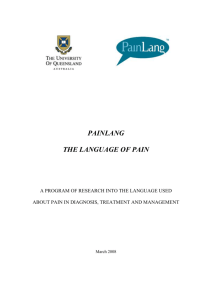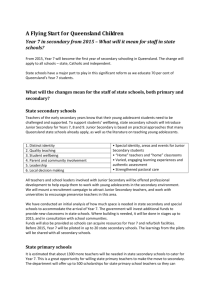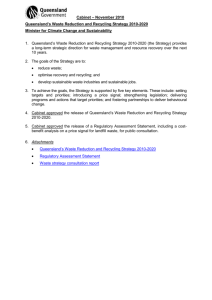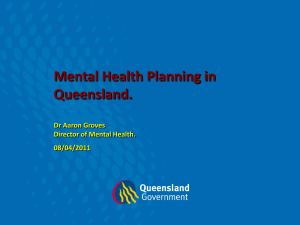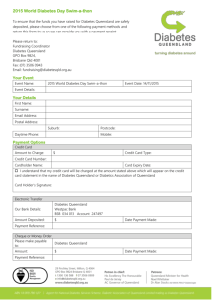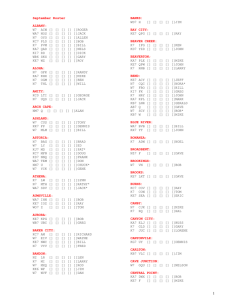Science 21 2010 Sample work program
advertisement
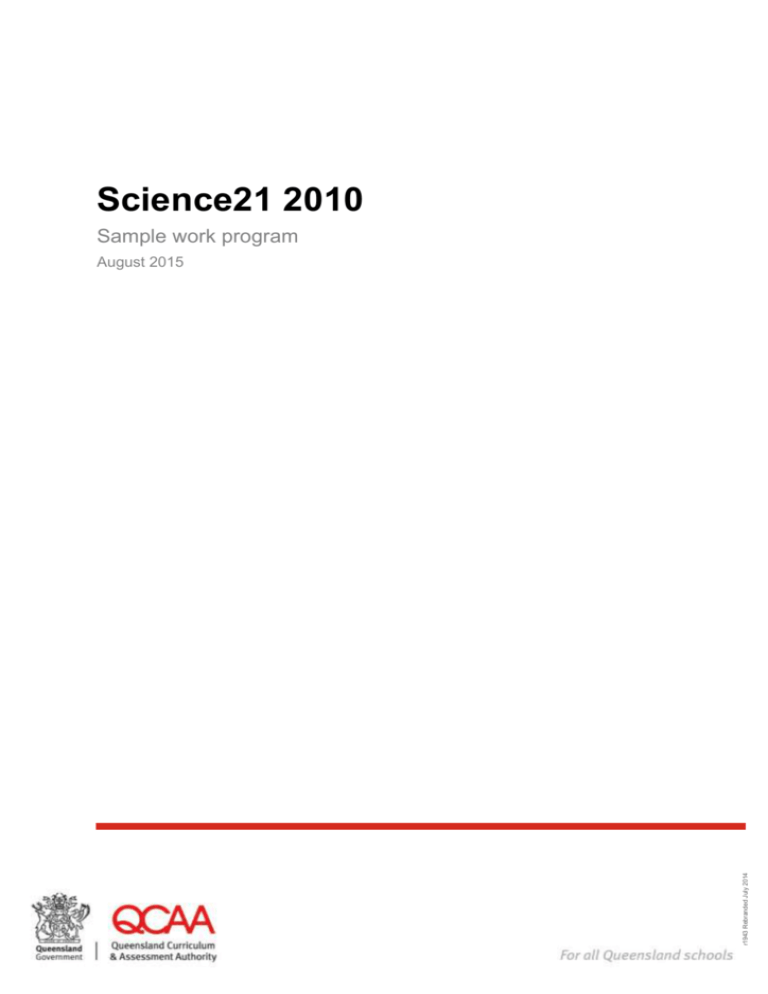
Science21 2010 Sample work program r1943 Rebranded July 2014 August 2015 Science21 2010 Sample work program Compiled by the Queensland Curriculum and Assessment Authority August 2015 A work program is the school’s plan of a course of study based on the relevant syllabus. Work programs allow for the characteristics of a school and its students to be considered when implementing the syllabus. School work programs must demonstrate that syllabus dimensions and objectives inform student learning. Work programs provide information about the school’s plan for course organisation, an outline of intended student learning and the assessment plan as outlined in the work program requirements for that syllabus. Science21 2010 Sample work program Queensland Curriculum & Assessment Authority August 2015 Page 2 of 13 1. Course organisation 1 2 3 4 30 hours Earth, wind and fire Verification Catalysts for discovery Environment 2 25 hours *Mythconceptions Open guided Health & wellbeing Technology 1, 2 1 25 hours Energy alternatives Open guided Environment Catalysts for discovery 3 2 1, 2 30 hours Our local creek Open Environment 2 3 20 hours Water, water everywhere Open Catalysts for discovery Health & wellbeing 1, 2 3 25 hours Driving in my car Open guided Technology 10 hours *Who wants to live forever? Open Health & wellbeing Catalysts for discovery 25 hours Who wants to live forever? Open guided Health & wellbeing Catalysts for discovery 30 hours Space, the final frontier Open guided Technology Environment 1, 2, 3 1, 2 Assessment 1 Technique General objectives Assessed Information & communication Energy Structure & properties of matter Focus areas and key concepts Earth & space Scientific priorities Living systems Inquiry type Time allocation Semester Context name Collection of work KCU, IP,I&I 1 Extended experimental investigation KCU, IP,I&I 1 Supervised written assessment KCU, II 2 Extended response task KCU, IP, I&I 2 Extended experimental investigation KCU, IP, I&I Collection of work KCU, IP, I&I Extended response task KCU, IP, I&I 1 1, 2 1, 3 1, 2 1 1,3 1, 2 1 1 Supervised written assessment KCU, IP, I&I 1, 2 1 Supervised written assessment KCU, IP, I&I 2,3 Science21 2010 Sample work program 2, 3 1 Queensland Curriculum & Assessment Authority August 2015 Page 3 of 13 2. Outline of intended student learning 2.1 Unit description — Earth, wind and fire Unit name Earth, wind and fire Semester 1 Time 30 hours Overview Students will investigate the underlying science behind a range of human and natural disasters, the impact on people and the environment, and the application of technology to predict or protect against disasters. Scientific priorities Technology Focus areas Structure and properties of matter Living systems Earth and space Energy Information and communication Key concepts SPI LS1 The cell as the basis of life ES1 Structure and properties of the earth EN1 IC1 SP2 Gases, liquids, solutions, solids LS2 ES2 Global cycles and the atmosphere EN2 Forces and motion SP3 Radioactivity LS3 Ecosystems ES3 Solar systems and the universe Solutes, solvents, Bushfire Plate tectonics — folding, Energy generated in Methods of detecting faulting, subduction, earthquake formation Weather patterns and cyclone formation Layers and composition of the atmosphere and the earth Impact of particulate matter in the earth’s crust due to tectonic movement Wave motion (Pwaves, S- waves & L- waves) in earthquakes and transmitting information (satellite imagery, seismographs) Transmission of analogue and digital signals (radio, television, satellites etc.) Molecular nature of Health & wellbeing Catalysts for discovery Environment Forms of energy matter Specification of key concepts solutions and emulsions Physical and chemical properties of crude oil Properties of materials that make Genes, genetics and evolution regeneration and succession — primary and secondary Science21 2010 Sample work program Storage, transfer and interpretation Queensland Curriculum & Assessment Authority August 2015 Page 4 of 13 them suitable for mopping up oil spills the atmosphere on global temperatures Location of asteroid belt in our solar system Behaviour and composition of meteors, comets and asteroids How waves travel Impact of solar activity through different media on transmission of signals Learning experiences Construct models of tectonic plates and investigate forces to link to folding, faulting and earthquakes Construct and operate a seismometer to gather data Interpret a seismogram to plot the epicentre of an earthquake Conduct investigations in wave motion Analyse weather patterns to identify trends in cyclone formation Unit outcomes Knowledge and conceptual understanding Critically evaluate disaster management strategies through discussions with SES Conduct investigations into ways to mop up oil spills Conduct a field study of sand dunes to observe succession and bushfire regeneration sites Make links between the effects of meteorite impact and the demise of dinosaurs Investigate the technology used to track asteroids Evaluate the effects of sunspot and solar flare activity on communication and technology Investigative processes Issues and impacts By the conclusion of the unit, students should be able to: Assessment overview State, describe (including modelling) and Conduct scientific investigations, such as field Identify and explain the issues underpinning explain biology, chemistry, earth science and physics concepts that underpin disasters. Explain interrelationships between the scientific ideas, concepts and processes observed during the investigations. Interpret and apply the gathered information and generate reasoned explanations. study of sand dunes to observe succession or bushfire regeneration sites and oil spill cleanup. Students will formulate questions and hypotheses, experiment and evaluate data. Use scientific and technological equipment such weather monitoring devices to gather data and information during practical investigations and research. Process, analyse, evaluate and interpret data from sources such as seismometers and synoptic charts, as well as anecdotal evidence and secondary data from case studies. disasters and disaster management and evaluate the impacts. Draw conclusions and express positions supported by scientific argument and evidence. Analyse a range of factors that influence the development of scientific knowledge and technologies. Supervised written assessment Extended experimental investigation Science21 2010 Sample work program Collection of work Extended response task Queensland Curriculum & Assessment Authority August 2015 Page 5 of 13 Students will construct a portfolio of documents relating to investigations into earthquake, oil spill, cyclone and meteorite impact disasters and the potential for disasters from predictions of sunspot activity in 2012. The portfolio will contain: scientific report on a short laboratory activity investigating properties of materials for cleaning up oil spills mapping exercise to predict the pathway of a cyclone from synoptic charts and data analysis to locate the epicentre of an earthquake including graphs multimodal presentation on succession and regeneration based on primary data from fieldwork scientific report on a short laboratory activity investigating the impact of atmospheric composition on temperature as a cause for dinosaur extinction report evaluating the impact of solar activity on technology used to transmit information. Science21 2010 Sample work program Queensland Curriculum & Assessment Authority August 2015 Page 6 of 13 2.2 Unit description — Space, the final frontier Unit name Space, the final frontier Semester 4 Time 30 hours Overview Students will explore space travel and the possibility of living in space or terra-forming another planet for human habitation. This unit explores the theories of force and motion needed to travel into space, and designs for space travel vehicles and space stations. Inquiries will include: the impacts of space travel on the human body; the requirements and processes needed to set up a space colony on another planet; technology for investigating our universe and beyond; and communicating information across great distances. Scientific priorities Technology Focus areas Structure and properties of matter Living systems Earth and space Energy Information and communication Key concepts SPI LS1 The cell as the basis of life ES1 EN1 IC1 Storage, transfer and Molecular nature of Health & wellbeing Catalysts for discovery matter Structure and properties of the earth Environment Forms of energy interpretation SP2 Gases, liquids, solutions, solids SP3 Specification of key concepts LS2 Genes, genetics and evolution Radioactivity LS3 Ecosystems ES2 Global cycles and the atmosphere ES3 and EN2 Forces and motion Solar systems the universe Requirements of Features of the planets & Generating artificial carbon-based life forms Biological effects of gravity on the human body: metabolism; heart & circulation; inner ear; immune system; kidneys; moons of our solar system Einstein’s theory of Relativity, black holes & worm holes Astronomic distance & time scales Composition of gases in ‘air’ and creating an gravity in a space station Kepler’s Laws Newton’s Laws Overcoming gravity for shuttle launch: action & reaction; momentum; inertia; circular & Science21 2010 Sample work program Communication systems — transmission of sound e.g. analogue to digital signal; fibre optics & digital superhighway; am/fm radio signals; LCD displays; networks to link computers Queensland Curriculum & Assessment Authority August 2015 Page 7 of 13 muscles & bones. artificial atmosphere elliptical motion Interactions required Astronomic distance & Light and lenses Electromagnetic to make a functional biosphere — biotic and abiotic factors Effects of cosmic radiation on living things time scales spectrum Red shift Doppler effect Applications of types of energy -lasers, holograms, radiotelescopes Learning experiences Construct a telescope and modify the design to improve its function Conduct investigations to find the link between composition of gases in the air with plant growth Conduct investigations into linear, circular and elliptical motion and analyse data using appropriate mathematical techniques Evaluate the features needed to make a planet suitable for habitation Describe the features of the planets and moons in our solar system (e.g. distance from the sun, atmosphere, size, composition) and extrapolate to determine the likelihood of finding other habitable planets Unit outcomes Knowledge and conceptual understanding Design, construct and investigate rockets Analyse the impact of drying foods for preservation and nutritional content Measure forces generated through circular motion, inertia, acceleration, etc. using theme park rides and evaluate their impact on the human body systems Link the methods of transmission of signals to the quantity and quality of information that can be communicated Investigate issues with communicating across space e.g. sound doesn’t travel in a vacuum Investigative processes Issues and impacts By the conclusion of the unit, students should be able to: State, describe and explain scientific Conduct research regarding factors that Analyse the range of factors that have information including facts, definitions, formulas, terminology, concepts and theories of forces and motion, and communication technology as they apply to space exploration. Explain interrelationships between the scientific ideas and processes in the development of an artificial ecosystem or space station. Use scientific knowledge and information to generate explanations of the effects of affect planetary motion and the function of space vehicles. Students will formulate questions and hypotheses, experiment and evaluate data. Select and present scientific ideas relating to space exploration to make meaning accessible to a general audience. Generate, process, analyse and evaluate data using appropriate qualitative and quantitative techniques to identify trends and interrelationships. influenced the development of theories involving space travel and colonisation, including the role of developing technology. Draw conclusions and express positions about the prospect of future human space exploration and life in space. Analyse a range of issues regarding living in space and developing colonies, and evaluate scientific impacts on the body and host planet. Science21 2010 Sample work program Queensland Curriculum & Assessment Authority August 2015 Page 8 of 13 gravity (or lack thereof) on the human body. Assessment overview Supervised written assessment Extended experimental investigation Collection of work Extended response task Short response prose (50 – 250 words per item) including stimulus response, calculations and secondary data interpretation. 2hr closed book, no notes allowed, stimulus seen. Science21 2010 Sample work program Queensland Curriculum & Assessment Authority August 2015 Page 9 of 13 3. Assessment plan 3.1 Overview Sem Inst Unit title Assessment technique Dimensions assessed Conditions 1 1 Earth, wind and fire Collection of work (Formative) KCU, IP, I&I Collection of a series of investigations about disaster case studies. The portfolio will contain: 2 scientific reports a mapping and graphing exercise with data analysis a multimodal presentation based on fieldwork a short research report . 6 weeks in class and own time 300–500 words per item Access to library and internet 2 Mythconceptions Extended experimental investigation (Formative) KCU, IP, I&I Students will use the scientific method to investigate the validity of a common ‘scientific’ claim. Journal submitted Pairs/small groups, individual reports 6 weeks 800 words for the analysis, discussion, recommendations and conclusions 3 Energy alternatives Supervised written assessment (Formative) KCU, I&I Sentence answers, short response prose (50–100 words per item) including stimulus response, calculations and secondary data interpretation. 1 ½ hr closed book No notes allowed Stimulus unseen 4 Our local creek Extended response task (Formative) KCU, IP, I&I Students choose an aspect of the Healthy Waterways report for their local creek, gather primary data to evaluate, and compare their findings to the EPA report. Based on their findings, students will make recommendations to improve the health of the creek. Report format 2 Science21 2010 Sample work program Queensland Curriculum & Assessment Authority August 2015 Page 10 of 13 Sem Inst Unit title Assessment technique Dimensions assessed Conditions Small groups, individual reports 6 weeks including field work and laboratory time 800–1000 words for the analysis, discussion, recommendations and conclusions 3 4 5 Water, water everywhere Extended experimental investigation (Summative) 6 Driving in my car 7 Who wants to live forever? KCU, IP, I&I Investigation of a water-related concept (e.g. osmosis, wetting agents, transpiration, solubility etc.) and its application/impacts. Journal submitted Pairs or individual, with individual reports 5 weeks 1200–1500 words for the analysis, discussion, recommendations and conclusions Collection of work (Summative) KCU, IP, I&I Collection of a series of investigations into vehicle design (engines, fuel, efficiency and pollution), forces, road surface and stopping distances, reaction time and alcohol. The portfolio will contain: 2 scientific reports based on field work a secondary research task data analysis task. Individual and group work. Individual responses 5 weeks 400–600 words per item Access to library and internet Extended response task (Summative) KCU, IP, I&I PowerPoint and oral presentation on a technology that can be used to treat a human condition. Students will evaluate the issues and impacts from the application of the technology as well as outline the scientific concepts underpinning its development and application. 4 weeks research 5–-8 minute oral presentation including PowerPoint and handout Science21 2010 Sample work program Queensland Curriculum & Assessment Authority August 2015 Page 11 of 13 Sem Inst Unit title Assessment technique Dimensions assessed Conditions 8 Who wants to live forever? Supervised written assessment (Summative) KCU, IP, I&I Short response prose (50–250 words per item), data analysis and problem solving. 1.5 hr closed book No notes allowed 9 Space, the final frontier Supervised written assessment (Post-verification) KCU, IP, I&I Short response prose (50–250 words per item) including stimulus response, calculations and secondary data interpretation. 2 hr closed book No notes allowed Stimulus seen Science21 2010 Sample work program Queensland Curriculum & Assessment Authority August 2015 Page 12 of 13 3.2 Student profile SEM UNIT TASK Dimension KCU 1 Earth, wind and fire 1. Collection of work Mythconceptions 2. Extended experimental investigation IP I&I INTERNAL REPORTING 2 Energy alternatives 3. Supervised written assessment Our local creek 4. Extended response task MONITORING 3 Water, water everywhere 5. Extended experimental investigation* Driving in my car 6. Collection of work* INTERNAL REPORTING 4 Who wants to live forever? 7. Extended response task* Who wants to live forever? 8. Supervised written assessment* VERIFICATION Space, the final frontier 9. Supervised written assessment EXIT *intended to be submitted at verification Science21 2010 Sample work program Queensland Curriculum & Assessment Authority August 2015 Page 13 of 13


